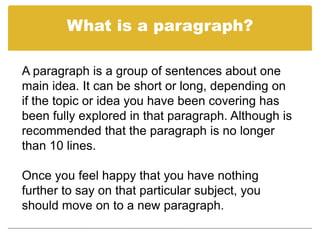
What is a paragraph
- 1. What is a paragraph? A paragraph is a group of sentences about one main idea. It can be short or long, depending on if the topic or idea you have been covering has been fully explored in that paragraph. Although is recommended that the paragraph is no longer than 10 lines. Once you feel happy that you have nothing further to say on that particular subject, you should move on to a new paragraph.
- 2. Paragraph structure A paragraph has 3 parts: The topic sentence: Is the main idea of the paragraph. Tells the reader what the paragraph is about. The supporting sentences: Add the details of the main idea. The concluding sentence: Summarizes the main points or rephrases the topic sentence.
- 3. Paragraph structure Topic sentence Supporting sentences Concluding sentence
- 4. Topic sentences The topic of a paragraph is generally introduced by a key sentence. This is called a topic sentence because it contains the central idea of the paragraph. It often -but not always- comes at the beginning of the paragraph. The topic sentence has 2 parts: Topic + controlling idea The topic is the subject of the paragraph and the controlling idea tells what the paragraph will tell about the topic.
- 5. Topic sentences Examples of: Topic + controlling idea • Pollution in ABC Town is the worst in the world. • Dogs can help you to live longer. • Teen pregnancy may be prevented by improved education. • It is important to be ready before buying a house • Swimming is the most effective and most injury-free aerobic exercise you can do.
- 6. The supporting sentences What are supporting sentences? They come after the topic sentence, making up the body of a paragraph. What do they do? They give details to develop and support the main idea of the paragraph. How do I write them? You should give supporting facts, details, and examples.
- 7. The concluding sentence The concluding or ending sentence closes or finishes the paragraph and should be related to the topic sentence. Ending sentences can: a) Repeat the topic sentence in a different way b) Summarize the information.
- 8. Example: writing about college The topic sentence could be: College is very important. These can be supporting sentences: You learn how to study. Teachers teach you how to organize your work. You learn how to use computers. The supporting sentences can be moved around so that the paragraph is in order or makes more sense. To strengthen your writing, make sure that each of your supporting sentences relates well to the topic sentence.
- 9. Example: writing about college The ending sentence can be: • It is important to go to college (repeating topic sentence) • So, it is important because you learn to study, to organize your work and to use computers.
- 10. Example: “Canada: the place to live” Canada is one of the best countries in the world. First, Canada has an excellent health care system. All Canadians have access to medical services at a reasonable price. Second, Canada has a high standard of education. Students are taught by well-trained teachers and are encouraged to continue studying at university. Finally, Canada's cities are clean and efficiently managed, and they have many parks and lots of space for people to live. As a result, Canada is a desirable place to live.
- 11. Example: “The forget sauce” Many fast-food chains make their profits from adding a special ingredient called "forget sauce" to their foods. This is the topic sentence. If this sentence controls the paragraph that follows, then all sentences in the paragraph must relate in some way to fast food, profit, and "forget sauce“ Made largely from edible oil products, this condiment is never listed on the menu. This sentence fits in with the topic sentence because it is a description of the composition of "forget sauce."
- 12. Example: “The forget sauce” "Forget sauce" has a chemical property which causes temporary amnesia in consumers. This sentence also fits in with the TS, because it discusses the “secret” behind the “forget sauce” After spending too much money on barely edible food bereft of any nutritional value, most consumers swear they will never repeat such a disagreeable experience. Now the paragraph moves on to the short-term effect on consumers.
- 13. Example: “The forget sauce” Within a short period, however, the chemical in "forget sauce" takes effect, and they can be depended upon to return and spend, older but no wiser. This sentence describes its longer-term effects. Returning customers mean more money to the fast-food chain and more money means more profit. So, the addition of the “forget sauce” to their foods represent a higher profit to these businesses. Finally, the paragraph finishes by "proving" the claim contained in the topic sentence, that many fast-food chains make their profits from adding a special ingredient called "forget sauce" to their foods.